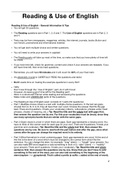Reading & Use of English
Reading & Use of English - General Information & Tips
• You will get 53 questions.
• The Reading questions are in Part 1, 5, 6 and 7. The Use of English questions are in Part 2, 3
and 4.
• Texts may be from newspapers, magazines, articles, the internet, journals, books ( ction and
non ction), promotional and informational material.
• You will get both multiple-choice and written questions.
• You will need to write your answers in capitals!
• The Reading parts will take up most of the time, so make sure that you have plenty of time left
for those.
• If you have time left, check for grammar, content and check if your answers are readable. If you
still have time left, then re-do hard questions.
• Remember, you will have 90 minutes and it will count for 40% of your nal mark.
• It’s absolutely crucial to CAREFULLY READ the questions and texts!
• Don't waste time on making the example-questions in every Part!
• TIPS:
• Don’t race through the ''Use of English'' part, do it with focus!
• However, do leave a lot of time left for the Reading part!
• Work in a structured manner while reading and answering the questions.
• Make notes and UNDERLINE parts of the questions.
• The Reading & Use of English exam consists of 7 parts (53 questions):
• Part 1 (Multiple-choice cloze) is a text with multiple-choice questions. In the text are gaps,
choose from A, B, C or D, they all have their own word. Choose the answer that ts the gap
best. There are 8 questions. It tests your vocabulary (idioms, collocations, phrasal verbs, xed
phrases, shades of meaning, etc.). Tip: Read the title and the whole text with gaps rst,
then answer the question one by one. For this your vocabulary must be broad, since they
use many synonyms/words that are similar with the same gaps.
• Part 2 (Open cloze) is a text in which there are gaps. Each gap represents a missing word. You
have to think of the correct word for each gap on your own. There are 8 questions. It tests your
grammar and vocabulary. Tip: Read the title and the whole text rst, then answer the
questions one by one. Be sure to read both the part before ánd after the gap, since what
comes after the gap can change the required word in its entirety.
• Part 3 (Word formation) is a text containing gaps. Each gap represents one word. At the end of
the line is the stem of a word which must be changed to the correct form which ts the
sentence. You can change the stem, for example: “long” (stem) —> “length” (your answer). You
can also make the word negative or add something in front of it: “able” (stem) —> “inability”
(your answer). There are 8 questions. It tests your vocabulary. Tip: Read the title and whole
sentence rst, then answer the questions one by one. Know that you don’t have to add
something to the end of the stem, you can also add something to the beginning of the
stem (explore —> unexplored). That’s called a pre x (a su x = added at the end of word).
2
fi fi fi ffi fi fi fi fi fi fi




